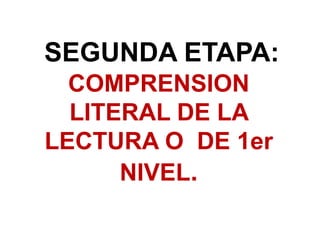
Comprensión Lectura
- 1. SEGUNDA ETAPA: COMPRENSION LITERAL DE LA LECTURA O DE 1er NIVEL.
- 2. Es la fase básica en el proceso de la comprensión lectora, pues se refiere a la capacidad del lector para reconocer la información explicita que comunica el autor. Tiene como propósito extraer toda la información que el autor ha expresado de manera directa en un texto Los mapas conceptuales de conocimiento o esquemas de organización son las herramientas básicas para organizar las ideas que presenta el autor
- 3. MAPA CONCEPTUAL DE CONOCIMIENTO O ESQUEMA DE ORGANIZACIÓN. ES UN DIAGRAMA QUE PERMITE RELACIONAR IDEAS, CONCEPTOS, OBJETOS O SITUACIONES. CADA MAPA SE SUSTENTA EN UN PROCESO DE PENSAMIENTO QUE GUÍA SU ELABORACIÓN LOS MAPAS GENERAN ESTRUCTURAS QUE FACILITAN EL PROCESAMIENTO, ALMACENAMIENTO Y RECUPERACIÓN DE INFORMACIÓN RECIBIDA POR MEDIO DE ESCRITOS LA ELABORACIÓN DE MAPAS PARA LA INTERPRETACIÓN DE ESCRITOS ES UN PROCESO PERSONAL QUE REFLEJA LAS INICIATIVAS E INTERESES DE LA PERSONA QUE LOS ELABORA
- 4. MAPAS CONCEPTUALES DEL CONOCIMIENTO O ESQUEMAS DE ORGANIZACIÓN DEL PENSAMIENTO TIPOS DE MAPAS O ESQUEMAS EXPLICACIÓN DIAGRAMA O ESQUEMA CARACTERÍSTICAS O VARIABLES SE DA UN OBJETO O SITUACIÓN Y SE MENCIONAN SUS CARACTERÍSTICAS . COMPARACIÓN SE ESTABLECEN CONTRASTES O DIFERENCIAS Y SEMEJANZAS CLASIFICACIÓN SE SEPARAN LOS ELEMENTOS DE UN CONJUNTO EN CLASES CLASIFICACIÓN JERÁRQUICA SE SEPARAN LOS ELEMENTOS DE UN CONJUNTO EN CLASES Y SUBCLASES DIAGRAMA DE FLUJO SE ORGANIZA SECUENCIALMENTE UNA SERE DE PASOS RELACION DE INTERCAMBIO SE ESTABLECEN RELACIONES DE ORDEN ETAPAS DE PROCESO DE ANÁLISIS SE ORGANIZAN LAS ETAPAS RESULTANTES DE LA DESCOMPOSICION
- 5. PROCEDIMIENTO PARA LA COMPRENSION LITERAL DE LA LECTURA. 1. LEE TODO EL ESCRITO DE MANERA GENERAL 2. IDENTIFICA EL TEMA O IDEA GENERAL DEL ESCRITO 3. RELEE EL PRIMER PÁRRAFO O PRIMERA PARTE 4. IDENTIFICA EL TEMA O IDEA DEL PÁRRAFO 5. COSTRUYE UN DIAGRAMA DEL PÁRRAFO 6. REPITE LOS PASOS 3,4, Y 5 CON LOS PARRAFOS SIGUIENTES HASTA AGOTAR LA PORCION DEL TEXTO 7. INTEGRA LOS DIAGRAMAS OBTENIDOS EN EL PASO 5 8. ELABORA UNA SÍNTESIS DE TIPO RESUMEN
- 6. EL TEXTO Y LOS PÁRRAFOS. EL BLOQUE FUNDAMENTAL DE CUALQUIER TEXTO SON LOS PÁRRAFOS. GENERALMENTE CADA PÁRRAFO ESTÁ CENTRADO EN UNA ÚNICA IDEA. LA LECTURA LITERAL NOS AYUDA A IDENTIFICAR ESA IDEA. PODEMOS CLASIFICAR A LOS PÁRRAFOS EN TRES TIPOS: DESCRIPTIVOS O NARRATIVOS PERSUASIVOS O CONVINCENTES EXPOSITIVOS O DECLARATIVOS
- 7. TIPOS DE PÁRRAFOS DE TEXTOS PROPÓSITO DEL EMISOR: CONVENCER: ¿SOBRE QUÉ? LA INFORMACIÓN ES VERDADERA. SU PUNTO DE VISTA ES EL CORRECTO. SE ACEPTE SUS IDEAS E INTERESES MEDIOS USADOS: ARGUMENTACIÓN: BASADA EN CREAR NECESIDAD. LA LÓGICA: EXPOSICIÓN DE RAZONES EXPOSITIVOS O DECLARATIVOS DESCRIPTIVOS O NARRATIVOS PERSUASIVOS O CONVINCENTES PROPÓSITO DEL EMISOR: COMUNICAR UN ESTADO DE ÁNIMO: ALEGRÍA, ENOJO, TRISTEZA, ANSIEDAD, MIEDO, ETC. MEDIOS USADOS: ORAL: USO TONO DE VOZ GESTOS Y POSTURAS EXCLAMACIONES PUNTOS SUSPENSIVOS USO DE DIMINUTIVOS PROPÓSITO DEL EMISOR: COMUNICAR UN EVENTO, HECHO, SITUACIÓN O DATO DE LA REALIDAD MEDIOS USADOS: DESCRIPCIONES NARRACIONES EXPOSICIÓN DE CAUSAS Y CONSECUENCIAS DE UN FENÓMENO. SE USA ORACIONES ENUNCIATIVAS LENGUAJE OBJETIVO, SENCILLO, CLARO DEFINICIONES
